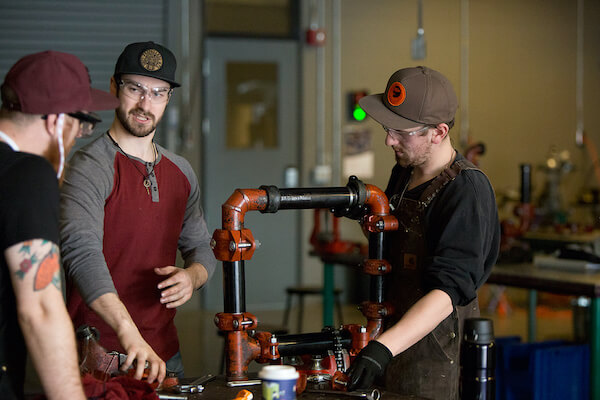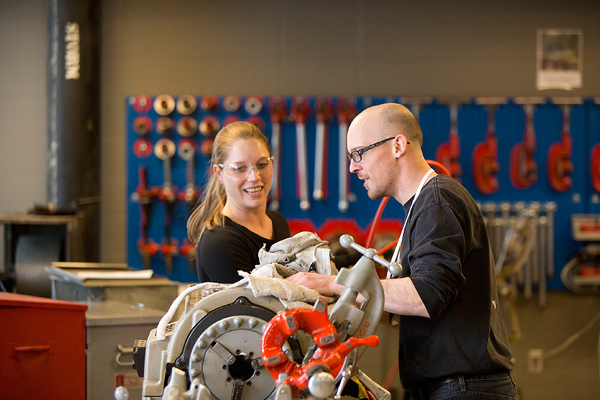On this page:
Overview
Learn to plan, install and service plumbing systems, fixtures, piping equipment and controls. These piping systems may be used to transport water, waste, gases or hot liquids.
On a typical construction job, you'll do the roughing in after the frame and roof of a new building are in place. This means you will:
- study the building plans and specifications to determine the layout for the plumbing and other materials
- locate and mark the positions for connections and fixtures
- cut holes through walls and floors to accommodate pipes
- select the type and size of pipe required and measure, cut, thread, bend, clamp, solvent cement or solder pipe
- assemble and install valves and fittings
- join pipe sections and secure them in position
- test pipe systems for leaks
- install underground storm sanitary and water piping systems.
You may also do residential repair and maintenance work in homes and commercial and institutional structures. You will provide customer service for renovations or common plumbing problems that occur in houses and multi-home structures.
To work in this trade, certification is required. This means that you must either be a registered apprentice who is working under the guidance of a certified journeyperson or you must be a certified journeyperson yourself.
The Alberta plumber apprenticeship program includes Gasfitter - Class B certification. This means plumber apprentices who successfully complete all the requirements for the Plumber program will receive two Alberta Journeyperson Certificates, Plumber and Gasfitter - Class B. Apprentices must write both the Plumber and the Gasfitter - Class B interprovincial exams to earn both Red Seal certificates.
Plumbers are skilled tradespeople who like collaborating with others or independently for a wide range of customers.
This line of work is most fulfilling for those who enjoy working with their hands in various environments and developing specialized skills.
To thrive in this career, it is important to have the following traits:
- creative problem solvers
- good customer service skills
- good math and science skills
- adaptable to working in different environments
- physical stamina to use proper lifting techniques for heavy pipes, being on feet for long periods, and working in cramped positions
- mechanical ability
- ability to accurately estimate and measure sizes and lengths
- ability to work independently or in a team
- commitment to safe working conditions.
Upon successfully completing the required working hours and apprenticeship education periods, graduates will be awarded an advanced diploma in addition to journeyperson status by Alberta’s Apprenticeship and Industry Training.
This is a Red Seal Endorsed trade – a recognizable standard that allows tradespeople to work across Canada.
Careers and opportunities
Our graduates may work in the following occupations. Some careers require additional experience and education.
Associated National Occupational Classification (NOC) codes: 72012, 72300, 72301, 72302, 72501, 74204, 92101.
Apprenticeship training
The term of apprenticeship for a plumber is four years (four 12-month periods), including a minimum of 1560 hours of on-the-job training and eight weeks of classroom instruction each year.
Year 1 | Period 1
You will start by learning standard workplace safety, rigging, tools, equipment and materials. You will then learn metal fabrication, drawing and specifications as well as calculation and science. All year 1 Plumber, Gasfitter, or Steamfitter apprentices will share a common first year, attending all classroom instruction and labs together.
Training length: 8 weeks
Year 2 | Period 2
You will then learn single-family dwelling drain-waste-vent and hydronic systems, heating systems, specialty piping as well as drawings, layouts and rigging.
Training length: 8 weeks
Year 3 | Period 3
You will then learn multi-family and commercial drain-waste-vent, single-family hydronic design, testing equipment and electrical components, gas systems as well as venting and air supply.
Training length: 8 weeks
Year 4 | Period 4
You will learn multi-story dwelling drain-waste-vent, private water supply and water treatment, wiring for appliances up to 400 MBH, appliances up to 400 MBH as well as commissioning and servicing.
Training length: 8 weeks
Apprenticeship education performance
You must pass each section of the course and the AIT exam to succeed in apprenticeship education.
The passing grade for each section in a course is 70%. A passing mark on each provincial exam and the interprovincial qualification (or Red Seal Exam) is 70%.
View Alberta's Apprenticeship and Industry Training procedures
Training pathways
You can earn your journeyperson designation in the following way.
The traditional training pathway begins with finding a job with an employer willing to indenture you as an apprentice. Once you are an apprentice, you will alternate between on-the-job training and educational periods.
You must apply for an apprenticeship through Alberta Apprenticeship and Industry Training before attending your first education period at SAIT.

Pre-employment pathway
SAIT’s Pre-employment Pipetrades program prepares you to enter into an apprenticeship with hands-on skills. Upon successfully completing the program, you’ll qualify to challenge the first-year Gasfitter, Plumber and Steamfitter Pipefitter apprenticeship exams.
Pre-employment PipetradesAdmission requirements
To enter an apprenticeship, you must have the educational qualifications required or recommended education for the trade to which you apply.
Entrance requirements are monitored and set by Alberta Apprenticeship and Industry Training.
Minimum requirements
Successful completion of the following courses:
- English 20-2
- Math 20-3
- Science 10
OR
A pass mark in all five Canadian General Educational Development (GED) tests
OR
Alberta Apprenticeship and Industry Training Entrance Exam
Recommended requirements
Apprentices with an Alberta High School Diploma that includes the following courses:
- English 30-2
- Math 30-3
- Physics 30 OR Chemistry 30 OR Science 30
- Related career and technology studies (CTS) courses

MyTradeSecrets
Once you have begun working as an apprentice, you can attend SAIT to complete your technical training.
You'll register for technical training at SAIT on MyTradeSecrets or you can register by phone.
How to registerAvailable intakes
Costs
2024/25 tuition and fees
The following costs are effective as of July 1, 2024.
Books or modules, along with other items for classes, are approximately $600 per period.
It's recommended you don't purchase books or modules ahead of time as they might be outdated by the time you attend classes, and they cannot be returned to the Bookstore.
Personal protective equipment (PPE) will be required for the program, which may be an additional cost to apprentices.
2023/24 tuition and fees
The following costs are effective until June 30, 2024.

Funding options for apprentices
Apprentices get to learn while they earn, but there are still costs to consider. Many resources are available at SAIT and federally to help support apprentices.
Financial aidInformation sessions
Prepare for a strong start in your chosen program or get the details you need to decide your future path.
Our expert staff and faculty are ready to answer your questions and provide information about the following:
- What sets SAIT apart
- An introduction to the program and area of study
- Admission requirements
- Future career paths
- Information on the earning potential and graduate employment rates.
Contact
Have more questions?
Apprenticeship training and registration
Apprenticeship and Industry Training Client Services
